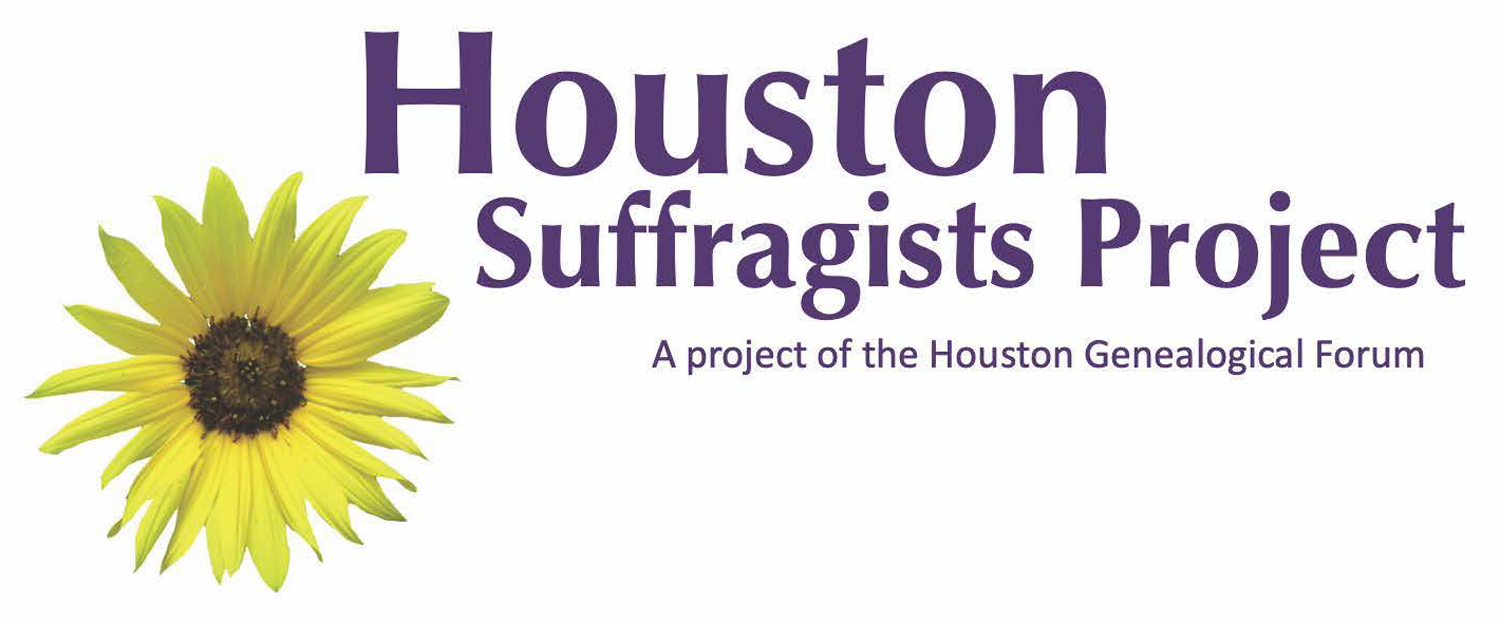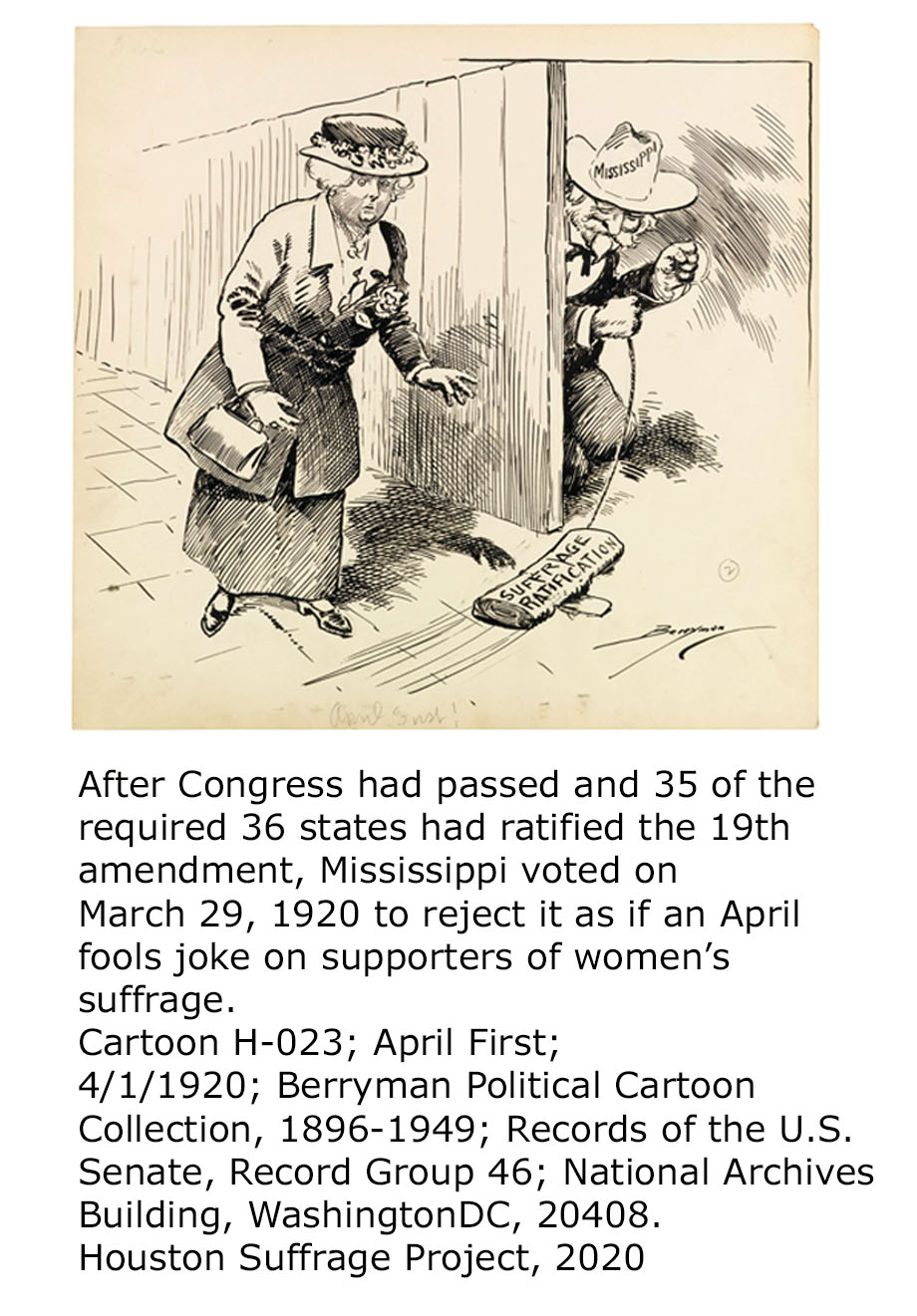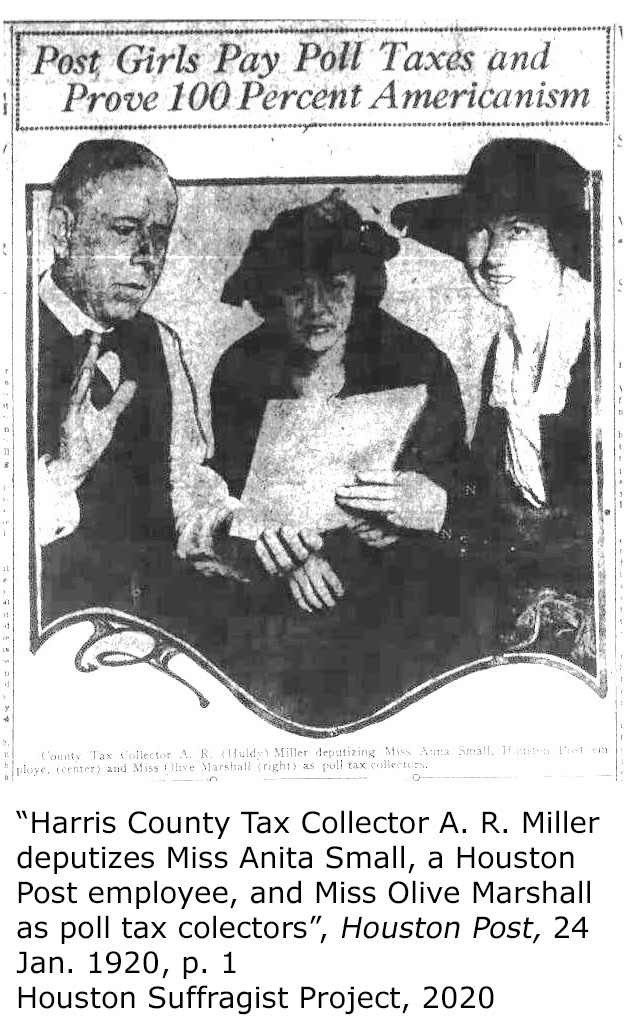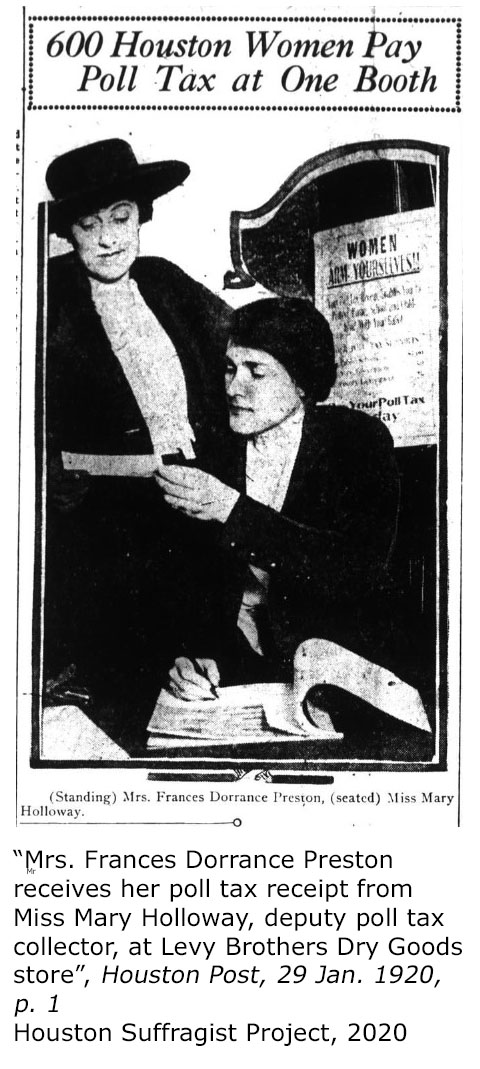
Statistical Summary of the Women Who Paid the 1920 Poll Tax
1918 - Women Gain Right to Vote in Texas Primaries
Just over a hundred years ago in March, 1918, Governor William Hobby called the special session of the Texas legislature which gave women their first right to vote in Texas. To secure that right, which was limited to political party elections, women would need to register.1 Exempted by the new law from paying the 1918 poll tax, 14,400 white women and 1200 Negro women registered to vote during a 16 day period that summer.2 Women went on to enthusiastically support Governor Hobby for the Democratic nomination for governor against James Ferguson who had opposed women suffrage.3
1919 - Women’s Right to Vote in All Elections Becomes Possble But Not Certain
 By late 1919, the political situation had changed. In June, the U.S. Congress had passed and the Texas legislature had ratified the 19th Amendment to the U.S. Constitution giving women the right to vote. By November, 22 of the 36 states required to ratify it had done so while 2 had voted against ratification. Ratification by 14 of the remaining 24 states was required for the amendment to become law and most of the remaining Southern states were expected to oppose it. It was possible that women would be able to vote in the November, 1920 elections but by no means certain.4
By late 1919, the political situation had changed. In June, the U.S. Congress had passed and the Texas legislature had ratified the 19th Amendment to the U.S. Constitution giving women the right to vote. By November, 22 of the 36 states required to ratify it had done so while 2 had voted against ratification. Ratification by 14 of the remaining 24 states was required for the amendment to become law and most of the remaining Southern states were expected to oppose it. It was possible that women would be able to vote in the November, 1920 elections but by no means certain.4
Few Women Pay the 1920 Poll Tax
To vote in 1920 party primaries and, depending upon the fate of the 19th amendment, in state and federal elections, Texas law required eligible women to either pay the poll tax or receive an exemption between October 1, 1919 and January 31, 1920. As is reported in The 1920 Elections, a second period of nine days opened for women to pay the poll tax in October just prior to the election.
 The Harris County Tax Collector, A.R. Miller, had hoped to make it easier for women and men to pay the poll tax by deploying deputy tax collectors to major department stores especially in the Third and Fourth Wards, in public school buildings, in the outlying First and Second Wards, and in more distant towns in Harris County including Goose Creek and Humble.5
The Harris County Tax Collector, A.R. Miller, had hoped to make it easier for women and men to pay the poll tax by deploying deputy tax collectors to major department stores especially in the Third and Fourth Wards, in public school buildings, in the outlying First and Second Wards, and in more distant towns in Harris County including Goose Creek and Humble.5
Following the end of the period to pay the poll tax, Tax Collector Miller estimated that almost 22,500 white men had paid the poll tax. In terms of eligibility to vote in the 1920 elections, in addition to those who had paid the tax, another 6,500 had soldier exemptions from paying the tax, and 3,500 (likely mostly men) were given exemptions because they were 60 years of age or older for a total of 32,500 white men who could vote in 1920 elections.6 The population of white male citizens over 21 years of age or old in Harris county was 41,219 so over 75% of the white men would be able to vote in the elections.7.
 Tax Collector Miller also estimated that only 2,000 women paid the poll tax during the first period ending in January, 1920 and another 1,000 during the second period in October.8 This is quite consistent with the 3,583 women found by the Houston Suffragists Project on the list of people who had paid the poll taxes during these two periods. This total, however, represented only 6.9% of the 52,063 women residents Harris county in 1920 who were 21 years of age or over and were citizens, clearly a significant decrease from the over 15,000 women who had registered in 1918.9
Tax Collector Miller also estimated that only 2,000 women paid the poll tax during the first period ending in January, 1920 and another 1,000 during the second period in October.8 This is quite consistent with the 3,583 women found by the Houston Suffragists Project on the list of people who had paid the poll taxes during these two periods. This total, however, represented only 6.9% of the 52,063 women residents Harris county in 1920 who were 21 years of age or over and were citizens, clearly a significant decrease from the over 15,000 women who had registered in 1918.9
Chart 1 shows that most of the Houston women who paid the tax lived in the more populous third, fourth, and seventh (formerly Houston Heights) wards. An especially popular place to pay the tax was the booth run by the League of Women Voters in the Levy Brothers Dry Goods store in the 300 block of Main street on the boundary between the third and fourth wards.10

Chart 1 - Race and Residence by Ward of Houston Women on Poll Tax List
Who were the women who paid the tax and why did so many fewer pay in 1920 than in 1918? The data gathered by the Houston Suffragists Project provides some insights.
The Poll Tax
While there were some changes in the political situation since 1918, the requirement for women to pay the poll tax for 1920 was the largest difference between the two periods.
The $1.50 poll tax was likely a significant burden for many working men and women. Skilled construction workers such as bricklayers, plumbers, gas fitters, and stone masons earned a union wage of $1.00 per hour, while building laborers were paid only $.43 per hour. In the book publishing industry, bookbinders received $.625 per hour and bindery women $.286 per hour union wages.11 More educated women could go into teaching where elementary school teachers earned between $800 to $1,500 per year. Annual salaries for high school teachers ranged from $1,100 to $1,800.12 Experienced stenographers could make $1,800 per year or more,13 effectively $.72 per hour with the typical 48-hour work week. Women in lower paid occupations or married to husbands with less income may have had the right to vote but not the means to pay the poll tax.
Women Who Paid Poll Tax Were Most Likely To Be Married White Housewives
The Suffragist Project found that 57% of the women on the poll tax list were married, white homemakers. This likely reflects the influence of women’s clubs among this group of women.
At the turn of the twentieth century as electricity came to more homes to power household appliances and as families became smaller, white, middle-class women in Texas had more time to form organizations to address community ills. Reform-minded women had realized that legislation was the key to achieving improvements and formed women’s clubs to lobby the legislature for these changes. They were especially interested in prohibition, improving public education, and women and child labor regulation.14
The Texas Federation of Women’s Clubs, which believed that the 19th amendment would be ratified, adopted resolutions urging their member clubs to hold poll tax campaigns. Club women could then vote for a proposed amendment to the Texas constitution on the November ballot that would free school districts to raise taxes for schools. The women’s club wanted to increase teacher pay, which they felt had been responsible for the loss of one-third of Texas school teachers the previous year, and provide more funds to improve and expand school facilities for rapidly growing populations.15 In Houston, a survey by the City Federation of Women’s Clubs found that most club women had paid the poll tax.16
Teachers Paid the Tax to Vote for Improvements in Education
Women who worked outside the home were 34% of all women who paid the poll tax. Of these, teachers formed the largest group with 22% of all women who worked outside the home. Like the club women, the teachers were also very interested in improving funding for education by voting for the proposed Texas amendment which allowed increased school taxes. The superintendent of the Houston Schools sent letters to all teachers urging them to pay their poll tax and arranging for deputy poll tax collectors to be available at meetings of teachers.17
Clusters of occupations and marital status are seen on the following chart of women from the poll tax list. Most of the married women who didn’t work gave their occupation on the Census as “None” indicating that they held no occupation outside of the home. These were likely the women’s club members. The next largest group were the teachers. When more than one occupation is given (e.g. Bookkeeper, Clerk), the first is taken from the Census and the second from the 1920 Houston City Directory.

Chart 2 - Women’s Trade or Profession by Marital Status

Chart 3 - Women’s Trade or Profession by Place of Employment
Many of the white women on the poll list were married to men in some of the higher income occupations which would be consistent with their membership in the women’s clubs.

Chart 4 - Husband’s Occupation

Chart 5 - Husband’s Place of Employment
Ages of Women
The distributions of the ages of the women on the poll tax list enhances our picture of these women. Most of the married women were in their late twenties, thirties, and forties while the single women were largely in their twenties, likely working before marriage as shown in Chart 6. Texas election law required that voters be 21 years of age or older to be eligible to vote and provided exemptions from the poll tax for anyone more than 60 years of age or those 21 at the time of registration.18 Women who held exemptions were not on the poll tax list or on the chart below.

Chart 6 - Age of Women on 1920 Poll Tax List by Marital Status
Racial Composition of Women
Most of the racial data reported by the Suffragists Project is taken from the 1920 Census which had two methods of racial classification. Census enumerators were instructed to use black for “Negroes of full blood” and mulatto for “all Negroes having some proportion of white blood”.19 There was provision to specify Chinese, Filipinos, and several other ethnicities as races but this did not include persons who today might be classified as ethnically Hispanic. It appears persons with Hispanic heritage were classified as white, black, or mulatto depending upon their Negro heritage.
In the 1920 Census Population Report, however, whites refer to “pure-blooded whites” while a person of mixed white and Negro descent was classified as a Negro “regardless of the amount of white blood”, i.e. persons marked as black or mulatto on the Census enumeration sheets were combined and referred to as Negro in the Census Summary Report.20 Persons who had been racially classified as Chinese, Filipino, or another ethnicity were combined and reported as a single total which typically represented only a very small percentage of the total Houston population.
The 1920 enumeration forms also asked for the nativity of each person and of their parents. The Census Summary Report contains totals for white persons from each country, e.g. a report for Houston shows the total number of white Houston residents who were born in Mexico and other countries.21 This report does not include country of birth for Negroes.
Following the end of the period to pay the poll tax for men, Tax Collector Miller estimated that about 3,000 Negroes had paid the tax.22 Most of these were men and represented about 22% of the 13,681 Negro male citizens over 21 in the county.23 Of the 2,953 women on the poll tax list for which race was found, only 201, 6.8%, were Negro including mulatto.
Women’s Occupation and Place of Employment by Race
The segregation in 1920 Houston is clearly reflected in the occupations and places of employment of the women on the 1920 poll tax list, as shown in the following charts. Many of the better-paid business occupations such as stenographer, clerk, bookkeeper, and saleslady were not open to Negro women who more typically were laundresses, washer women, or domestics.

Chart 7 - Women’s Occupation

Chart 8 - Women’s Place of Employment
Election Results
As described in The 1920 Elections, nine days before the election, Texas District Judge John D. Harvey ruled that the recent law passed by the Texas legislature requiring women to pay the poll tax for 1920 was not constitutional and that women could vote without having paid the tax. While there are no direct counts of the number women who took advantage of this opportunity, reports from election judges can be used for an estimate.
During the first poll tax payment period ending in January, about 3,000 Negroes, almost all men, had paid the tax24 and then voted in about the same numbers as in previous elections.25 Election officials estimated that about 7,100 Negroes voted, implying that about 4,000 - 5,000 of these were Negro women. Since about 28,750 people voted, about 22,000 of these would have been white men and women. Based on reports from precinct election judges that white women at least equaled the number of white men at the polls, at least 11,000 white women came to the polls for a total of 15,000 - 16,000 women who voted.26 This estimate is very close the 14,750 number of women who registered to vote in the 1918 primary elections when the poll tax was not required which further supports the idea that a great many women wished to vote but were prevented by the poll tax.
Summarizing:
- Negro women: 4,000 - 5,000
- Negro men: 2,000 - 3,000
- White women: 11,000
- White men: 11,000
- Total Women: 15,000 - 16,000
Harris county women split their votes largely along racial and party lines. About 5,500 Negro votes went to Black and Tan party candidates, who typically finished third in their contests, while the remaining 1,600 Negro votes went to the Republican party. White women probably voted for Democrats and Lilly White Republicans in about the same proportions as white men. Despite the large number of women who went to the polls, their votes don’t seem to have changed any election outcomes with Democratic candidates receiving well over 50% of the votes in most races as expected.27
The school amendment, which carried by a large majority, likely benefited from the women’s votes and support of the women’s clubs.
Epilogue
Issues with Women voting in their first election and whether women would pay the poll tax were major news stories of 1920 but, by the next year, that women would vote and pay the poll tax was accepted and the focus had shifted to the administration of the tax. In July, 1921, Texas voted to amend the constitution to allow a husband or wife to pay the poll tax for the other spouse.28 By the end of 1921, Texas Comptroller had ruled that the poll tax was not optional but a mandatory tax29 and the Texas Attorney General that if the property was community property, the poll tax for both husband and wife were required to be paid when the property tax was paid.30 While the number of women who paid their poll tax isn’t known, because of these new requirements, a significant number of women likely were on the new poll tax roles. The number of people paying the poll tax increased from 28,500 in 1920 to 44,000 in 1922,31 and to almost 58,000 in 1924,32 double the number of 1920. In only a few years, women had become established as part of the electorate and a major factor to be considered by every campaign.
The new school tax amendment passed in 1920 would be needed a few years later. By 1922 the Houston schools were facing a budget shortfall which would require reductions in teacher salaries if new revenue was not found.33 Houston voters responded by approving an increase in the city school tax rate in May, 1922 by a vote of more than 3 to 1.34 Both passage in 1920 of the school tax amendment and approval in 1922 of the tax increase benefited from the support of women and women’s clubs.
References
A. Elizabeth Taylor,“Woman Suffrage”, Handbook of Texas, Texas State Historical Society https://www.tshaonline.org/handbook/entries/woman-suffrage↩︎
“14,400 Women Can Vote in Primary in Harris Co.” The Houston Post, 13 July 1918, p. 1↩︎
“Heavy Vote Rolled Up, Especially by Women; Hobby Carrying City,” The Houston Chronicle, 27 July 1918, p. 1↩︎
“US Women’s Suffrage Timeline 1648 to 2016”, National Park Service, https://www.nps.gov/articles/us-suffrage-timeline-1648-to-2016.htm↩︎
“Only a Few Women Pay the Poll Tax”, The Houston Chronicle, 20 January 1920, p. 12↩︎
“Voting Strength Placed at 37,500”, The Houston Chronicle, 5 February 1920, p. 19↩︎
W.M. Stuart, Director of the Census, “POPULATION-TEXAS, Table 9.-Composition and Characteristics of the Population, for Counties: 1920”, Reports of the Fourteenth Census of the United States, Volume III Population, Bureau of the Census, Department of Commerce, Government Printing Office, 1922, pg 1000↩︎
“Poll Tax Paid by 26,000 in Harris County”, The Houston Chronicle, 1 February 1920, p. 1; “County Collector Says 1000 Qualified by Paying Poll Tax”, The Houston Chronicle, 22 October 1920, p. 23↩︎
Ibid. 7; Ibid. 2↩︎
Ibid. 5↩︎
“Table A.-Union Scale of Wages and Hours”, Union Scale of Wages and Hours of Labor, May 15, 1919, Bureau of Labor Statistics, U.S. Department of Labor, Government Printing Office, Washington, 1920, pgs 83, 85, 127, 193, 199↩︎
“Raise School Teachers Pay 20 Per Cent”, The Houston Chronicle, 7 January 2020, p. 7↩︎
“County to Cut Salary Melon”, The Houston Chronicle, 9 August 2020, p. 7↩︎
Betty Trapp Chapman, “Building Community Institutions”, Houston Women: Invisible Threads in the Tapestry, The Donning Company Publishers, Virginia Beach↩︎
“Federation Women Are Urged to Pay Poll Taxes”, The Houston Chronicle, 5 December 2019, p. 24↩︎
“Women Urged to Pay Their Poll Tax”, The Houston Chronicle, 7 January, 2020, pg. 13↩︎
“Urge Teachers to Pay Their Poll Tax”, The Houston Chronicle, 14 January, 1920, p.2↩︎
Ibid. 6↩︎
Sam L. Rogers, Director of the Census, Instructions to Enumerators, Bureau of the Census, Department of Commerce, Government Printing Office, Washington, 1919, p. 27↩︎
Ibid. 7, p. 1382↩︎
Ibid. 7, p. 1026↩︎
Ibid. 8↩︎
Ibid: 7↩︎
Ibid. 8↩︎
“Democrats Have Big Lead in Harris County, Republicans Second”, The Houston Post, 3 November 1920, p. 1↩︎
“Clerk Receives Complete Returns From All Districts”, The Houston Post, 6 November 1920, p. 1↩︎
“Clerk Receives Complete Returns From All Districts”, The Houston Post, 6 November 1920, p. 1↩︎
“Texas Voters Native Born or Naturalized”, The Houston Chronicle, 9 September 1921, p. 4↩︎
“Poll Tax Payment Does Not Depend On Wish to Vote”, The Houston Chronicle, 13 December 1921, p. 2↩︎
“Must Pay Wife’s Poll Tax as Well As Property One”, The Houston Chronicle, 8 December 1921, p. 1↩︎
“Expect Voters of County Will Number 50,500”, The Houston Chronicle, 2 February 1922, p. 12↩︎
“Harris County Vote is 61,347 Records Show”, The Houston Chronicle, 3 February 1924, p. 1↩︎
“Appeals For Increase In School Tax”, The Houston Chronicle, 4 May 1922, p. 9↩︎
“Bond Issues And Tax Raise for Schools Voted”, The Houston Chronicle, 7 May 1922, p. 1↩︎